In this detailed comparison, I’ll look at the Roborock Q7 Max vs Dreame L10 Pro to find out the pros and cons of each and, most importantly, how they differ. For a quick view, both robots boast a plethora of intelligent features but lack the absence of a self-emptying function. They can also mop the floor, yet they don’t exactly excel in this department. The Roborock Q7 Max vacuums better, while the Dreame L10 Pro can detect and avoid some large enough obstacles thanks to its front-facing 3D sensor.
Roborock Q7 Max Vs Dreame L10 Pro: Comparison Chart




Roborock Q7 Max Vs Dreame L10 Pro: Differences
The Q7 Max defeats the L10 Pro with a score of 4-3. Next, I’ll analyze all the differences between these hybrid robots.
Cleaning Performance
Winner: Roborock Q7 Max
Suction Power
| Roborock Q7 Max | Dreame L10 Pro | |
|---|---|---|
| Max Suction (Pa) | 4200 | 4000 |
| Max Airflow (CFM) | ≈ 15.8 | ≈ 17.1 |
Looking at the Pa figure, the Q7 Max has a higher suction of 4200 Pa compared to the 4000 Pa maximum suction of the L10 Pro. Surprisingly, my airflow tests showed that the latter has more airflow with a negligible increase. Higher airflow has only helped the L10 Pro get a higher score on my hardwood floor, while the Q7 Max performed better on carpets.
Hard Floor
| Roborock Q7 Max | Dreame L10 Pro |
|---|---|
| ≈ 97% | ≈ 98% |
Robot vacuums tend to excel on my hard floors, and both the Q7 Max and L10 Pro are no exception to this rule. The L10 Pro got a higher percentage thanks to its higher airflow. The difference is not much, but it proves that airflow is a significant factor on hard floors and why the L10S Ultra is the better option for tackling this type of flooring.
Carpet
| Roborock Q7 Max | Dreame L10 Pro | |
|---|---|---|
| Low-pile Carpet | ≈ 94% | ≈ 91% |
| High-pile Carpet | ≈ 95% | ≈ 89% |
I initially hoped the higher airflow would translate into superior deep cleaning results, but this was not the case. The Q7 Max got higher scores that could potentially be attributed to its all-rubber brush roller.
Hair
| Roborock Q7 Max | Dreame L10 Pro | |
|---|---|---|
| 5-inch Strands | ≈ 87% | ≈ 82% |
| 10-inch Strands | ≈ 61% | ≈ 53% |
In the realm of hair clean-up, the results for both machines were decent but not great. The Q7 Max, once again, was better at picking up hair and resisting tangles. Its brush wasn’t 100% tangle-free, and there was a moderate amount of long hair wrapped around its bristle-free roller and on the axles, but cleaning it was easy. On the other hand, the L10 Pro’s roller can be maintained with ease using the cleaning tool provided.
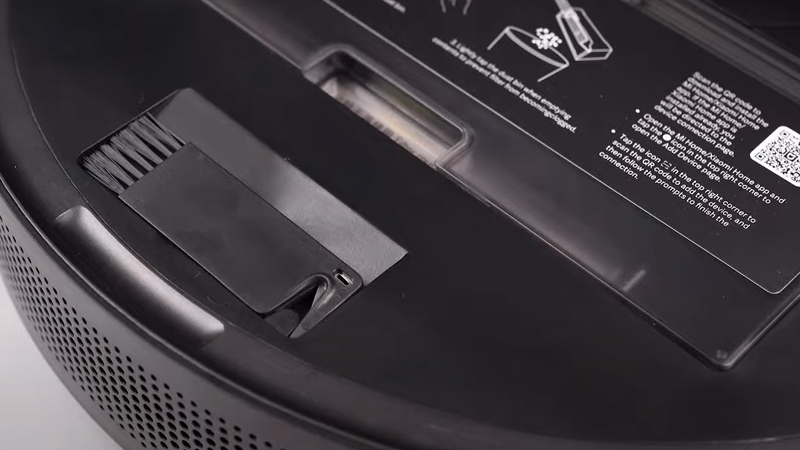
Design & Usability
Winner: Tie
First Look & Dimensions
| Roborock Q7 Max | Dreame L10 Pro | |
|---|---|---|
| Dimensions (W x H) | 13.8 x 4.17 inches | 13.8 x 3.8 inches |
| Weight | 9.59 lbs | 8.38 lbs |
The design and shape of the Q7 Max and L10 Pro are typical of many robot vacuums on the market, with a circular-shaped body, a centrally-located LIDAR tower, and a few buttons for manual control. They are not overly heavy or large, making them manageable and practical for everyday use. The L10 Pro is a bit lower, so it can slide under a greater variety of furniture. Their build quality is also pretty good.
Speaking of box contents, both the Q7 Max and the L10 Pro come with all the necessary accessories you would expect from hybrid robot vacuums. This includes a water tank, a dustbin, a main brush, a side brush, a docking station, a power cord, a filter (already installed), and an owner’s manual – All the consumables aren’t hard to buy separately. The L10 Pro comes with a tool for cleaning the brushes and can be stored on-board to ensure it never gets lost and is always at hand when you need it.
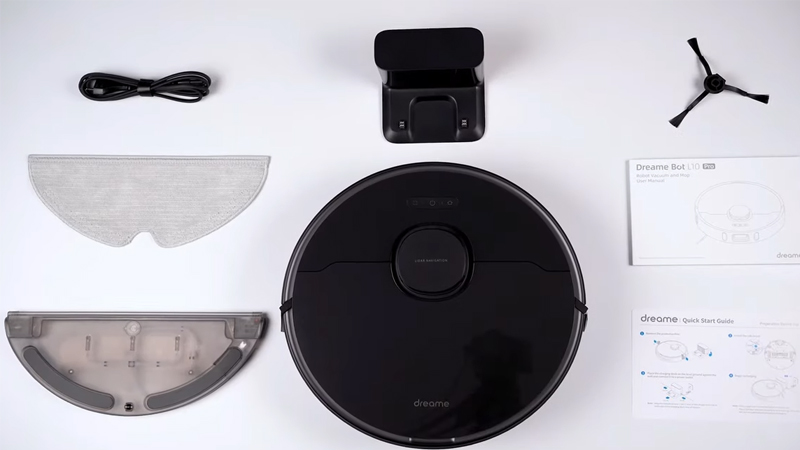
While the L10 Pro comes with a separate dustbin and a separate water tank, the Q7 Max features a dustbin and water tank assembly. The latter design choice might save space, but, in my opinion, it can make the process of emptying the dustbin or refilling the water tank less convenient since you have to remove and handle both parts at once.
Extractor & Side Brush
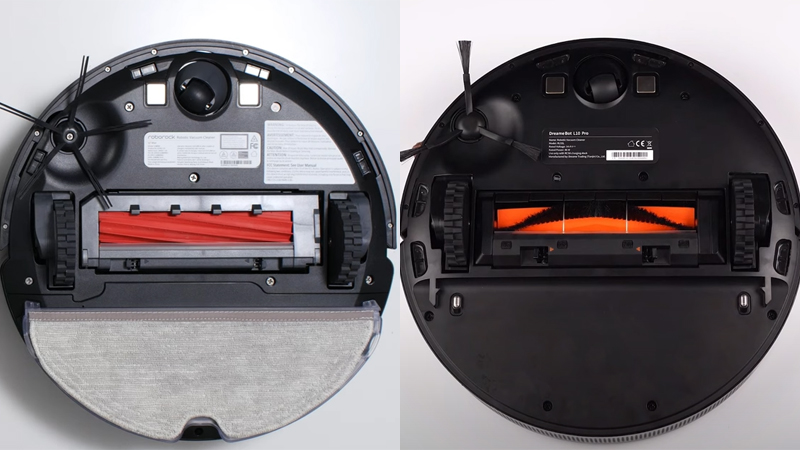
The L10 Pro features a spiral brushroll that combines spiral bristles and composite paddles. The bristles can gently sweep debris on hard surfaces without scratching them, while the rubber paddles can agitate carpet fibers to loosen and pick up more embedded dirt or debris. It can be taken off from both sides for cleaning, but not as easily as you would with the all-rubber roller on the Q7 Max, of course.
Both of these bots use a single corner brush to sweep debris from edges and corners to the central cleaning path. The Q7 Max uses an all-rubber side brush, which gives it an advantage in durability over the bristled brush on the L10.
Navigation
Speaking of mapping and navigation, these bots are absolutely spectacular. They both use a top-mounted LiDAR sensor, or rather, laser beams, to quickly and accurately map your space, even in low-light environments. Then, during cleaning, they go along the perimeter before moving in a back-and-forth pattern to ensure no untouched spots are left behind.
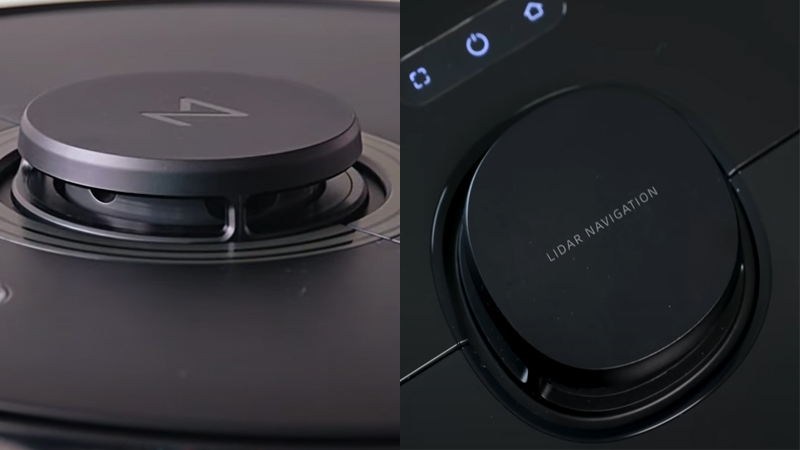
Both can save multiple maps, which is great, too. The L10 Pro can save two map levels, whereas the Q7 Max can save up to four. So just place them on a new floor, and they’ll intuitively understand whether to craft a new map or switch to the appropriate one, should they have traversed that floor previously.
Unique to the L10 Pro is a “High Precision 3D” sensor on the front to detect and evade objects. On paper, this system features three individual laser sensors to improve accuracy and provide a wider field of view. It’s better than a camera-based sensor in that it can function without relying on light, but it can’t capture quick snapshots of objects like the Roborock S7 MaxV could.
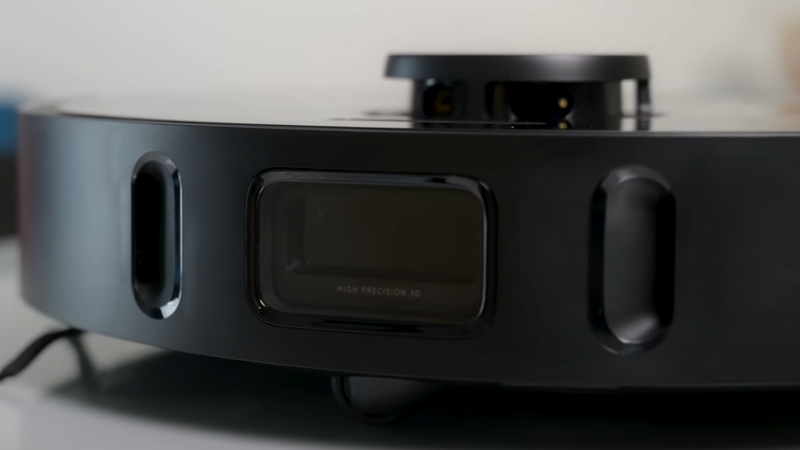
In the real world, the L10 Pro’s 3D laser-based sensor did the job but wasn’t perfect. It still sucked up loose or dangling cords and small objects like Lego blocks. Also, its side brush was partly touched against pet feces. So, after all, I’d recommend giving your floor a preliminary clean-up to minimize mishaps.
Battery Life
| Roborock Q7 Max | Dreame L10 Pro | |
|---|---|---|
| Battery Life | ≈ 91-183 mins | ≈ 62-156 mins |
| Charging Time | ≈ 198 mins | ≈ 212 mins |
Both use a 5200 mAh battery, equal to the capacity of a smartphone, which is not bad at all. According to the specifications, a full battery should be enough for several hours of work, but in reality, it all depends on the power setting and conditions of cleaning. When low, these bots will return to the dock, recharge, and resume cleaning from the last place they cleaned.
Control
Winner: Roborock Q7 Max
Manual Control
Both share a set of three buttons: a dock button, a power button, and a spot-clean button. That means you can turn the robot on/off, send it home, or clean a small area without your cell phone. I loved the spot-cleaning function – just put it on an area you need to clean, press the button, and it will efficiently clean a square area in snake form.
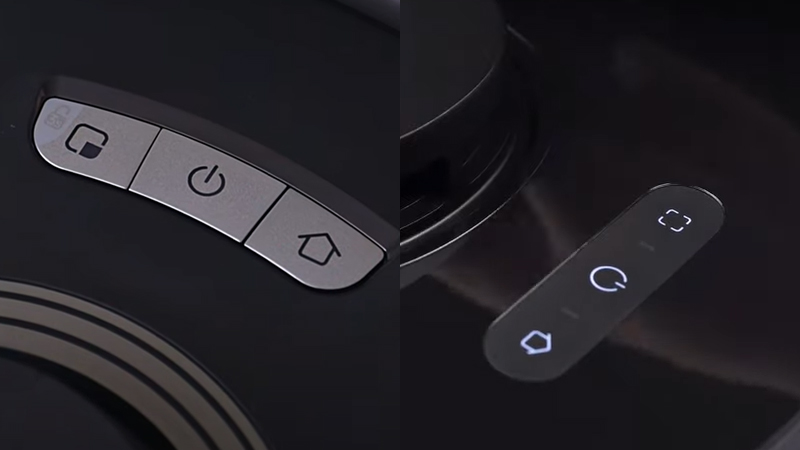
App Connectivity
These bots are compatible with smartphone apps, Roborock and Dreame apps, respectively, and I’d recommend downloading them to maximize functionality.
One of my favorite features that they both share is the live map, which shows the robot’s exact location in real time and all the areas it has cleaned. The Q7 Max can draw 3D maps, show all the visible walls and no-go zones, and enable you to add furniture to make it look more “real.”
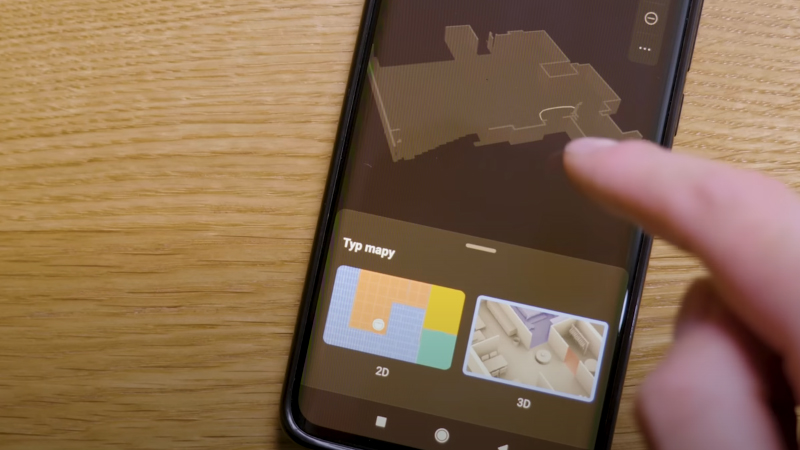
You can also divide or merge rooms before naming them. But while the Roborock app allows you to use both preset and custom names, the L10 Pro only allows you to use preset names. Then you can select a room on the map that needs cleaning. And you know what? You can even do it by voice, as long as you have Alexa or Google Assistant.
Both the Q7 Max and L10 Pro can save multiple maps, as mentioned above, and within each map, you can add invisible walls or no-go zones to block some off-limit areas. You also have the option to draw no-mop zones to prevent them from wetting your carpeted areas when mopping. Another convenient feature is the ability to draw rectangular or square boxes on the map, delineating clean zones where the robot will then concentrate its cleaning efforts.
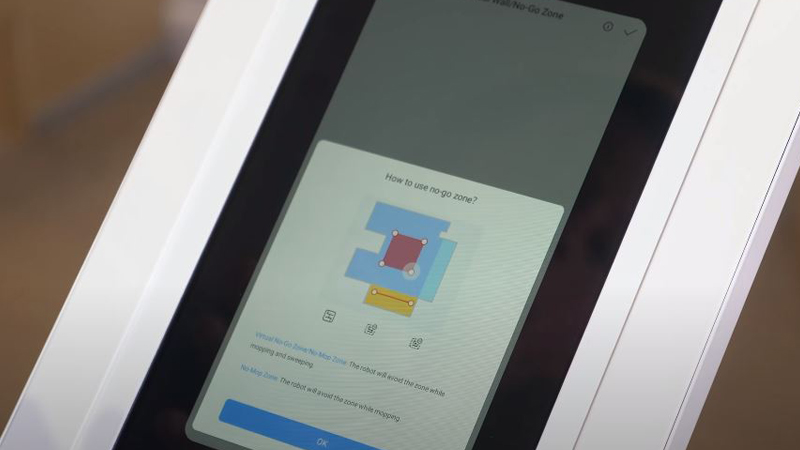
Another cool feature is unlimited scheduling, which allows you to set as many runs per day with the option to select time, power settings, and water flow options. You can also check out the previous cleaning cycles and get a quick overview of the status of consumable parts, including the side brush, main brush, and filter.
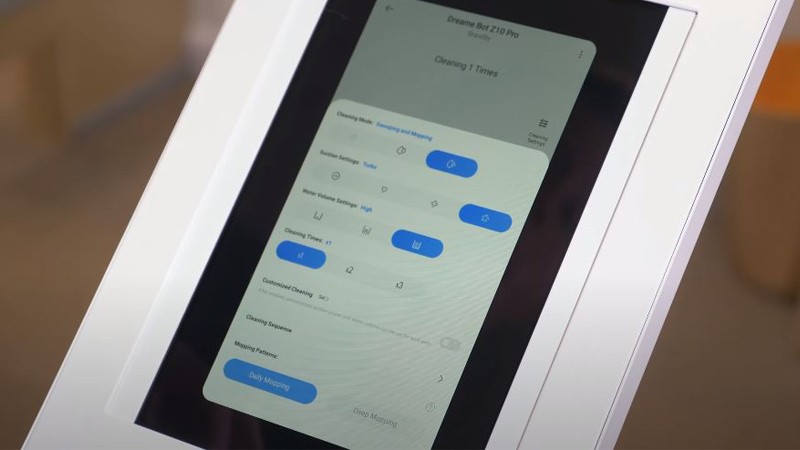
Cleaning & Maintenance
Winner: Tie
Speaking of maintenance, you need to get your hands on many tasks because these bots don’t come with self-emptying bases. The to-do list includes emptying the dustbin, refilling the water tank, washing the mopping pad, checking the brushroll for tangles and clogs, cleaning the filter, and replacing consumables as needed.
Let’s face it, none of us enjoy these tasks, especially busy people. Both Roborock and Dreame have introduced various do-it-all models, such as the Q7 Max Plus or Dreame Z10 Pro, which can self-do everything, from emptying the dustbin and refilling the water tank to washing and drying the mopping plate. Of course, these models are exorbitantly expensive because of the unparalleled convenience and hands-free experience they provide.
Other Features
Winner: Dreame L10 Pro
Noise
| Roborock Q7 Max | Dreame L10 Pro | |
|---|---|---|
| Working | ≈ 59-75 dB | ≈ 52-69 dB |
| Self-Emptying | None | None |
The L10 Pro is the quieter option due to its lower airflow. This one reaches 63 dB at the maximum setting compared to the Q7 Max, which goes up to 75 dB. Anyway, that’s not a big deal since they only use maximum power when cleaning carpeted surfaces, and almost none of us have the robot vacuum on late at night, right?
Mopping Ability
Both are 2-in-1 robots, meaning they can vacuum and mop at once. Having a robot that can do multiple tasks is great, but I honestly didn’t appreciate their mopping abilities. Why? This is because I quickly realized that these bots didn’t have any form of agitation or scrubbing motion to lift stubborn dirt. They just drag damp pads across the floor, so they are better suited for light mopping tasks. What’s more, they have no mop-lifting system, so just don’t forget to delineate no-mop zones on the map to keep your carpets dry.
Quick Rundown Of Roborock Q7 Max
- Deeper Cleaning with Powerful 4,200 Pa Suction: With 4,200 Pa maximum suction, the Q7 Max effortlessly lifts debris and pet hair from floors, drags dirt from cracks, and deep-cleans carpets; it automatically boosts suction when carpets are detected, ensuring thorough cleaning
- Vacuum and Mop Simultaneously: To eliminate fine dust that vacuuming alone might miss, this robot vacuum can vacuum and mop in one go; its electronic pump offers 30 adjustable water flow levels, allowing you to customize cleaning based on floor type and preference
- Clean Smarter with PreciSense LiDAR Navigation: Highly accurate LiDAR technology builds precise 3D maps of your home and identifies the most efficient cleaning routes; virtually recreate your space by adding furnishings and flooring materials for a more tailored cleaning experience
- Combined Dustbin & Water Tank: The 470 ml dustbin and 350 ml water tank combination supports longer cleaning sessions without the need for frequent emptying or refilling
- Effortless Cleaning with All-Rubber Brush: The all-rubber brush is specifically designed to resist tangles from long hair and pet hair; its multi-directional floating design maintains close contact with the floor, ensuring deeper and more efficient cleaning
Quick Rundown Of Dreame L10 Pro
Product Videos
Related Articles to Roborock Q7 Max
- Roborock Q5+ Vs Q7 Max: Which Roborock Robot Should You Choose?
- Roborock Q7 Max Vs S7: What Are the Differences Between Them?
- Roborock Q5 Vs Q7 Max: An In-Depth Analysis
- Roborock Q7 Max Vs Xiaomi S10T: A Detailed Comparison
- Roborock Q7 Max Vs Eufy X8: What Is The Best Option For Your Home?
- Viomi S9 Vs Roborock Q7 Max: Battle of the Feature-Rich Bots
- Viomi V5 Pro Vs Roborock Q7 Max: Which One Gets My Winning Ticket?
- Roborock Q7 Max Vs Dreame Z10 Pro: A Detailed Face-Off Comparison
- Roborock Q Revo Vs Q7 Max: Duel of the Roborock Dust-Suckers
- Dreame D10 Plus Vs Roborock Q7 Max: An In-Depth Comparison And Review
- Roborock Q7 Max Vs Q7: What Does The “Max” Label Refer To?
- Dreame D9 Max Vs Roborock Q7 Max: Which Chinese Brand Does the Job Better?
- Roborock Q7 Max Vs Q7 Max Plus: Is the Self-Cleaning Base A Game Changer?
- Roborock Q7 Max Vs S7 MaxV: Which Roborock Is Better?
- Roborock Q7 Max Vs iRobot J7: A Head-To-Head Comparison
References:
- Roborock Q7 Max: https://us.roborock.com/products/roborock-q7-max
- Dreame L10 Pro: https://www.dreametech.com/products/dreame-l10-pro

Richard B. Schmidt is a prominent figure in the vacuum cleaner industry, boasting over 15 years of expertise. Armed with a Robotics Engineering degree from Northeastern University and a Master’s in Consumer Science from Harvard, his unique blend of technical knowledge and consumer insights positions him as a sought-after authority in vacuum cleaner evaluation. Richard’s career began at Dyson, where he contributed to the development of innovative vacuum models. Transitioning to advocacy and reviews, he co-founded the first Vacuum-focused blog in 2008, offering comprehensive analysis and user guides for various vacuum cleaners. In 2020, he founded RoboMop.net, providing ongoing insights through columns and buyer’s guides.
